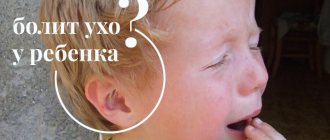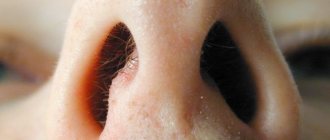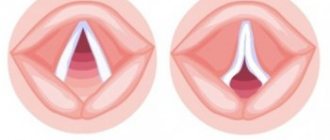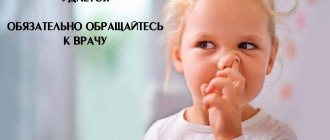Nose bruise - symptoms and treatment
→ Home treatment → Emergency conditions → Bruise
During a head injury, the nose is often affected. It is located on the front of the skull. If the doctor has determined that the nose is bruised, this means that the bone structures and cartilage are not damaged, and only the soft tissues are damaged.
Often such injuries are accompanied by swelling, bleeding, and a head injury is also accompanied by a concussion.
If this happens, you must seek qualified help from a surgeon and traumatologist, otherwise the consequences can be serious.
- Reasons why a bruise occurs
- Differences between a bruise and a broken nose
- Symptoms of a nasal fracture
- Signs of a nose bruise
- First aid
- Treating a bruise at home
- Traditional methods of treatment
- Complications and consequences
Reasons why a bruise occurs
A nasal injury can occur at any age; no one is immune from it. But children, teenagers and the elderly are most susceptible to it. In middle age, such injuries are less common.
Elderly people suffering from diseases of the musculoskeletal and nervous systems often fall - on the street, from the stairs, and children suffer during a fight, in sports, due to excessive physical activity, or carelessness.
Let's look at the most common causes of a nose bruise in adults and children:
- Ice in winter and associated falls.
- Colliding with hard objects, hitting your face against a wall, tree.
- Active children's games involving running and jumping. A child's nose is damaged if another child accidentally hits him with a toy or pushes him.
- Injury can be caused by other people, such as being struck by a ball or a blunt object.
- Work related to height. Damage often occurs when falling from a height.
- Car crashes. The consequences are sometimes worse than a bruised nose.
- Sports wrestling - judo, boxing, karate.
- Meeting with hooligans on the street or a domestic fight.
Having listed the risk factors, we can say that a nose bruise occurs as a result of the impact of a blunt object on the tissues of the face - due to injury, impact and fall.
Differences between a bruise and a broken nose
Signs of a bruise are similar to a fracture. Only a doctor can distinguish them after conducting a series of medical studies. The code for a nose bruise according to ICD 10 is S00, it is indicated in the diagnosis and certificate of incapacity for work. To differentiate between injuries, the symptoms of both injuries should be considered.
Symptoms of a nasal fracture
If the nose is broken, the signs are as follows:
- the patient feels severe pain at the slightest touch of the nose;
- swelling that spreads to the bridge of the nose and under the eyes;
- hematoma in the area of the fracture;
- deformation of the nasal septum;
- noticeable crunch upon palpation;
- heavy bleeding that occurs when blood vessels rupture;
- impaired nasal breathing due to swelling of soft tissues and displacement of the septum.
A fracture of the nasal bones is determined by palpation and confirmed by radiography. This should be done by a doctor.
Signs of a nose bruise
You can identify a bruised nose by characteristic signs:
- pain in the area of injury;
- difficulty breathing, but not as severe as with a fracture;
- swelling of the nose and under the eyes;
- lacrimation immediately after injury;
- bruising may appear under the lower eyelids;
- moderate pain on palpation.
A patient with tissue damage may experience bleeding, which will immediately stop with cooling. If the bruise is minor, it usually goes away in one to two weeks, without complications. The first signs (swelling and hematoma) decrease after a couple of days.
Important! If a severe bruise of the nose is combined with a concussion, then the symptoms are different. Dizziness, fainting, nausea, and in some cases vomiting, and severe headaches occur. Hemorrhages appear under the membranes of the eyes.
First aid
After an injury, it is important to provide first aid so as not to worsen the damage. In this case, certain rules must be followed, on which the rapid restoration of nasal function depends. Help needs to be provided not only quickly, but also correctly.
- First of all, you need to calm the victim.
- You should try to immobilize him as much as possible to stop the bleeding. The best option is to sit the patient down and tilt his head slightly forward. Encourage him to breathe through his mouth. This is necessary to prevent blood from entering the nasopharynx. If the bruise is not accompanied by bleeding from the nose, the head is tilted back. When a child is injured, he should not be allowed to run and jump.
- If the wound is open, it should be washed with an antiseptic. Chlorhexidine or hydrogen peroxide will do. A small wound can be sealed with a bactericidal adhesive plaster.
- Next, procedures are performed that will help reduce the duration of bleeding. To do this, apply a cold application to the back of the head and the bruised area on the nose. Any item from the refrigerator can be used as a compress. It must be wrapped in soft cloth. It should be applied for 10–15 minutes with breaks of an hour.
- When the bleeding is profuse and even a compress cannot cope, then tourniquets are made from cotton wool or sterile gauze. The swabs are then dipped in hydrogen peroxide and inserted into each nostril. This will stop the bleeding faster.
- For headaches, the victim is given painkillers: Ketorol, Baralgin, Panadol, Nurofen.
- If the injury is severe, you need to call an ambulance to transport the adult or child to a traumatologist.
Important! Timely consultation with a surgeon or traumatologist will help avoid serious consequences. If x-rays rule out a fracture, your doctor will prescribe a treatment plan that can be done at home.
Treating a bruise at home
When carrying out treatment at home, you must perform the following activities:
- ice on the nose for a few minutes (10–15), every two hours;
- use ointment - Heparin or Troxevasin - to eliminate swelling;
- for external wounds, treatment is carried out with antiseptics;
- for prolonged swelling and difficulty breathing, the patient is prescribed vasodilating nasal drops;
- Warming up may be prescribed (several days after the injury);
- use analgesics to relieve pain;
- After a few days, the doctor may prescribe physical therapy.
If all medical requirements are met, the disease goes away quickly; if the nose is severely bruised, treatment is carried out in a hospital.
Traditional methods of treatment
Often medical measures are used in combination with folk remedies. Recovery occurs faster when using herbal medicine:
- Using a decoction of dry buttercup grass. A few spoons of medicinal raw materials are poured with boiling water and left for 30 minutes. Then filtered and cooled. This decoction is used to make a lotion, applying it to the surface of the nose for congestion.
- To relieve swelling and inflammation, use a white cabbage leaf. It is thoroughly crushed until the juice appears (after keeping it in the refrigerator), then applied to the nose. The procedure is repeated every two hours.
- As an alternative, raw potatoes are used. It is cut into small pieces and attached with a bandage to the bridge of the nose.
- Crushed aloe leaf and honey mixed in equal portions are applied to the damaged area. This compress will eliminate pain.
Important! You should not self-medicate, even if the herbs are safe. First you need to get a doctor's permission.
Complications and consequences
Sometimes blood does not completely flow out of the nasal passages and accumulates inside. Clots are an excellent habitat for microbes. Symptoms indicating hematoma infection occur:
- headache;
- the temperature rises;
- signs of intoxication appear.
If the injury to the facial part of the skull involved a displacement of the nasal septum, a deformity of the nose occurs. A hump appears at the site of displacement due to the growth of additional cartilage tissue. This is a serious cosmetic problem. The deformity sometimes makes breathing significantly more difficult. Changing the shape of the nose is corrected surgically.
As a consequence of damage to the nose, sometimes a prolonged runny nose occurs, which is accompanied by whistling. If treated incorrectly, the infection can affect the maxillary sinuses - the victim is diagnosed with sinusitis, sinusitis, and rhinitis.
For prevention, you need to avoid injuries, talk with children about caution and proper landing when falling. Athletes are taught this during training. It is better not to send older people on a walk alone. If you cannot avoid injury, you should immediately consult a doctor for help.
Source: https://lechim-prosto.ru/ushib-nosa.html
Complications and consequences
If you treat a bruised nose promptly and competently, you don’t have to worry about developing any complications. But if the injury turned out to be too complex, the wound became infected, incorrect measures were taken, and not immediately, treatment will have to be done under the strict supervision of doctors.
The most common and dangerous complication of a nose bruise is the addition of an inflammatory process. When an infection gets into the area with the hematoma, the body temperature rises, the pain becomes more intense, and a feeling of fullness occurs in the nose. These are the main symptoms of the onset of inflammation. To avoid its development, it is necessary to make a puncture. The main indication for puncture is a large hematoma that takes a long time and does not completely resolve.
If, however, the inflammatory process has begun, its treatment should be as intensive as possible. After all, this complication can lead to very serious consequences - for example, meningitis or a brain abscess.
Other consequences that most often appear as a result of bruises include:
- a constant runny nose, which significantly complicates breathing (because of it, a person sniffles, whistles and snores);
- vasomotor sinusitis, rhinitis and sinusitis, occurring in a chronic form;
- deformation of the nose with changes in its size, as well as deviated septum.
Bruise of the nose and bridge of the nose - how to identify and what to do
A bruised nose and bridge of the nose is a facial injury that occurs frequently. Most of these cases occur with children - as a result of a fall or blow while playing, riding a bicycle, sledding, skating or other outdoor games.
Adults are more likely to suffer such injuries during a fight or due to an accident. Statistics show that in winter the number of such injuries increases, and they are caused by falls due to ice or winter sports.
Athletes who engage in boxing, kickboxing and other types of wrestling also often get bruised noses.
Symptoms and signs
In order for treatment to be successful, it is important to determine what type of injury was encountered: a broken nose or a bruise.
The bruise is accompanied by the following symptoms:
- acute pain - it is usually stronger than with a fracture, and even light touches to the nose cause severe pain;
- swelling and swelling quickly appear; because of this, the nasal passage narrows, which leads to difficulty breathing;
- if nasal breathing is not facilitated by instillation of vasoconstrictor drops, there is a possibility of a hematoma in the area of the nasal septum;
- bruising of the soft tissues of the nose is often accompanied by hemorrhage, so after the blow bruises appear located directly on the bridge of the nose or under the eyes;
- vascular damage leads to profuse nosebleeds;
- The eyes may become watery in the first 2-3 hours after injury.
Since a bruise implies that the bone tissue remains undamaged, this injury cannot cause deformation of the nasal bones. If the bones of the bridge of the nose are displaced, most likely it is a fracture.
However, immediately after a blow, when the tissues swell, it is difficult to distinguish displacement from edema. Another reason to be wary is the discharge of clear or blood-stained fluid from the nose after the bleeding has stopped.
This fluid is the cerebrospinal fluid that bathes the brain, and its leakage from the nose indicates damage to the ethmoid bone.
A strong blow to the face is likely to cause a concussion.
If the patient experiences dizziness, nausea and loss of coordination, he should immediately consult a doctor.
Some babies develop a blue spot on the bridge of their nose that looks like a bruise. If there have been no falls or other traumatic situations, most likely there is no need to worry: this is not a bruise, but a small-caliber vein that shows through thin skin. In this case, the spot will become brighter when the child cries, due to the fact that blood flow to the face increases.
Further treatment
Even if, after first aid, the symptoms of a bruised nose and bridge of the nose have weakened, the next step should be to contact a traumatologist and perform an endoscopic or x-ray examination prescribed to exclude a fracture. Based on the results of the study, the doctor will select treatment. It may include the following procedures:
- cold compress on the damaged area;
- daily treatment of an open wound, if any;
- a course of physiotherapeutic procedures (for example, electrophoresis).
Along with the procedures, drug treatment is prescribed:
- painkillers: if the bruise is in an adult - Analgin, Ketorol, if in a child - Paracetamol, Nurofen;
- ointments for the treatment of tumor (edema) and hematoma: Heparin, Troxevasin, etc.;
- vasoconstrictor drops to relieve edema: Rinazolin, Naphthyzin, Sanorin, etc.
With timely and proper treatment, the bruise goes away within 14 days.
Recovery is slowed down by a concussion and a hematoma in the internal parts of the nasal septum - it appears if, due to a blow, a detachment has occurred and blood has entered the septum. If such a hematoma exists, it is necessary to puncture it to avoid inflammation.
During treatment, it is recommended to lead a gentle lifestyle, avoid hypothermia and not wear glasses. It is also worth remembering that during this period it is easy to aggravate the resulting damage to the nasal septum. Therefore, you need to try in every possible way to avoid falls, bumps and sudden movements.
Treatment with folk remedies
Folk remedies help eliminate the unpleasant symptoms of a nose bruise and avoid complications. However, you need to take into account that in the first days after injury, cold is necessary. But warming procedures are permissible no earlier than the third day. In addition, all of the following can only be used after consulting a doctor.
- To make your nose hurt less, you can use a decoction or alcohol tincture of buttercup flowers. These products should be used to gently rub the bruised area. This procedure should be done 2 times a day.
- White cabbage will help cope with inflammation and swelling. Take a cabbage leaf and crush it a little to release the juice. Apply to the injured area, securing it securely with a bandage. This compress needs to be changed hourly.
- Raw potatoes are an excellent alternative to cabbage, as they do the same job perfectly. You can make night compresses from it, after grating it or cutting it into thin slices.
- For subsequent warming up of a bruised nose, a compress of boiled pureed beans is suitable. The duration of one session is 15 minutes. Then the compress can be washed off with water at a comfortable temperature.
- To get rid of unattractive bruises, you should use hot soaks with Epsom salts. If you don’t have this ingredient, you can take heated sand, regular table salt and a hard-boiled chicken egg. Such warming up should be done no more than 3 times a day. Please note that you cannot go out into the cold air after them.
- Natural honey will help relieve pain and reduce inflammation. To make a compress, you will need to mix honey and finely chopped aloe leaves in a 1:1 ratio. It should be applied to the injured area no more than 3 times a day. In addition, the product prepared for the compress is suitable for treating wounds and abrasions - this way they will heal faster.
The above methods remain effective for mild injuries. If the injury turns out to be severe or has complications, such remedies will not help. You will need to take medications prescribed by your doctor.
What to do if you bruise your nose and how to quickly relieve swelling and cure swelling
A nasal bruise is an injury that requires an immediate response, knowledge of how to quickly cure swelling of the damaged soft tissues of the nose.
How to distinguish a bruise from a fracture
Hitting the bridge of the nose does not always result in a fracture or swelling of the nose. Everything is determined by the force of the blow. Before determining what to do in case of a bruise, the injured person needs to find out the severity of the damage to the nose. To begin with, they pay attention to the clinic of the injury, and only then determine what to do in each specific case.
When bruised, the following signs appear:
- difficulty breathing;
- swelling and pain.
When fractures occur, the following signs appear:
- pain syndrome manifests itself more clearly;
- at the point of fracture of the nasal septum, a hematoma quickly develops, spreading to the eyes.
Important: you can accurately determine the type of injury and what to do in this case only based on the results of instrumental diagnostic methods (for example, x-rays).
First aid for bruises and injuries to the nose
In a situation of injury, it is important to take timely first aid and treatment actions. The necessary actions and knowledge of what to do in case of blows to the nose will improve the physical condition of the victim and help shorten the recovery time after a bruise.
List of activities: what to do and how to help with nose bruises:
- Calm and sit the victim. Don't let him make sudden, active movements. This advice is especially relevant for children, whose strong crying can provoke bleeding.
- Place a compress of ice, snow, or just a wet cloth on the bridge of your nose. This is one of the important rules of what to do if your nose is broken, allowing you to quickly relieve swelling and pain.
- Treat wounds and scratches with an antiseptic solution.
- If blood comes from the nose, the victim must be seated and his head tilted. When struck in the nose, blood entering the respiratory tract can provoke attacks of suffocation. To stop bleeding, you can use cotton wool soaked in an antiseptic solution.
Attention: do not remove the cotton swab from your nose before half an hour.
- Take the victim to the emergency room. Even if the symptoms of the bruise have passed, the injured person needs to see a doctor who can determine the presence or absence of a fracture of the bridge of the nose and determine what to do next.
We recommend further reading Nasal swelling from allergies
Possible consequences of injury to the bridge of the nose
Ignorance of the rules of what to do in case of injuries or lack of attention to a bruise can lead to the development of serious complications, of which the most dangerous is a concussion.
After a blow, the following problems may arise: difficulty breathing (provoked by swelling of the nose), changes in the timbre of the voice, the development of a problem of lack of smell, and the appearance of a callus at the site of injury.
The most common consequences of a blow to the nose are:
- change in the shape of the nasal septum;
- snoring and sniffling;
- inflammation of the nasal septum (as a result of the development of chronic sinusitis);
- development of allergies.
The mucous membranes of the nasal passages damaged during a bruise cease to protect the body from the penetration of infections. As a result, chronic infectious diseases debilitating the body develop. In particularly severe situations, the infection penetrates into other parts of the skull, causing life-threatening inflammatory processes.
Important: a bruise to the head or bridge of the nose can be so severe that, in addition to external signs (hematomas, swelling), it is accompanied by a concussion.
The main signs of a concussion are: nausea, dizziness. If such signs appear, the victim must be taken to the hospital as soon as possible, where the doctor determines what to do next in this case.
Treatment
After first medical aid is provided, the victim is examined by a doctor, who determines treatment for the injury, helping to quickly cure the bruise and swelling of the nose.
The course of therapeutic therapy includes several points:
- Cold compresses.
- Drug treatment.
- Physiotherapy.
Medications
One of the measures to take when dealing with a bruised bridge of the nose is to take the following medications:
- Ointments for bruises (Heparin, Traxevasin ointment) these products help reduce swelling and have a beneficial effect on the condition of blood vessels.
- Along with taking steps to relieve swelling from a bruise, the doctor prescribes painkillers (Analgin, Ketorol, Nurofen for a child), which quickly relieve pain.
- Doctors prescribe vasoconstrictor drops (Rinazolin, Naftizin) for impaired breathing caused by swelling of the nasal tissue.
Attention: in case of severe injuries, the victim is admitted to a hospital for a detailed examination and the necessary medical therapy.
Classification of nasal injuries
The solid “framework” of the nose consists of three paired cartilages located on the sides of the nose and one unpaired quadrangular cartilage - the nasal septum. At the top of the nose, cartilage connects to the paired nasal bones, which form the dorsum of the nose. Adjacent to the nasal bones on the sides are the frontal processes of the upper jaw, forming the superolateral surfaces of the nose. In depth, the nasal septum is connected to the perpendicular plate of the ethmoid bone. On top, the cartilage and bones of the nose are covered with skin and soft tissue.
The following types of nasal injuries are distinguished:
- soft tissue damage;
- damage to the cartilage of the nose (usually the nasal septum is injured);
- damage to the bone structures of the nose (fractures of the nasal bones without displacement and fractures with displacement of fragments).
All types of injuries can be closed (without violating the integrity of the skin) or open (violating the integrity of the skin). Open injuries (wounds) of the nose can be penetrating or non-penetrating into the nasal cavity.
Nasal injuries are often combined with traumatic brain injury. A concussion is accompanied by nausea, dizziness and headache.
Nose bruise: degree and severity, symptoms, first aid at home and treatment methods
Contusion of the bridge of the nose and nose represent a trauma to the facial skull. There are no gross changes in the bone structure of the face with this injury; generally pathological disorders affect only soft tissues.
What to do if you have a bruised nose
A bruised nose can also be accompanied by a concussion. Therefore, this damage should not go untreated.
Factors for nose bruising
In what cases does a nose bruise occur? In medicine, there are three main causes of injury: a fall, a blow from a blunt object, and physical pressure.
Children are injured during outdoor games, cycling, sledding, and skating.
An adult is injured as a result of a fall or blow during a fight or in connection with an accident. Elderly people suffer from bruises due to a chronic disease that affects coordination of movements, changes in blood pressure, dizziness, and sudden weakness.
Medical statistics show that in winter the number of these injuries increases due to ice or winter sports. Also at risk are athletes involved in boxing, kickboxing and other types of wrestling. They also often receive fractures and bruises to the nose.
Symptoms of injury
Symptoms of a bruise in some cases are similar to the signs of a fracture, and if there is no violation of the integrity of the skin, this does not mean that a fracture of the nasal bone has not occurred.
Any bruise of the nose in a child or an adult is accompanied by a group of specific symptoms . Their manifestations depend on the severity of damage to the soft tissues and bone structures of the nose.
You can distinguish a nasal bruise from a fracture by the main signs:
- Intense pain - it is no stronger than with a fracture, but even a light touch to the site of the bruise causes severe pain.
- Puffiness and swelling develops quickly. For this reason, the nasal passage narrows and breathing becomes difficult.
- If, after using vasoconstrictor drops, nasal breathing does not become easier, this indicates the presence of a hematoma in the area of the nasal septum.
- Bruising quite often accompanies bruising of the soft tissues of the nose. Therefore, after a blow, bruises appear, localized on the bridge of the nose or under the eyes.
- The resulting vascular damage leads to severe nosebleeds.
- The first 2-3 hours after injury, the eyes water.
Deformation of the nasal bones when bruised in an adult or child does not occur, since the bone and cartilage structure remains without serious damage.
In the case when the bones of the bridge of the nose are displaced, we can talk about a fracture, but it should be remembered that immediately after the impact the tissues swell and it is difficult to distinguish displacement from swelling. Nasal discharge should also be a cause for concern after the bleeding has been stopped. This fluid is the cerebrospinal fluid that washes the brain, and its flow from the nose indicates damage to the ethmoid bone.
Pronounced symptoms of a bruised nose are observed in the first three days, later they subside.
A blow to the nose can cause damage not only to the bone structure and soft tissues of the nose itself, but also to the structure of the brain, and therefore, possibly, the appearance of other symptoms of injury. Therefore, it is necessary to know the signs associated with a concussion:
- Immediately after the injury, dizziness and fainting.
- Nausea, vomiting.
- Intense headache.
- Hemorrhage into the sclera of one of the eyes.
Diagnostics
Competent medical care for a bruised nose will be provided only in the clinic and after a full examination.
To make a diagnosis, the following measures should be taken:
- Rhinoscopy helps to identify the presence or absence of deformation of the nasal tissues and the location of the septum. Nearby tissues are also examined and the extent of their damage is assessed.
- Anamnesis collection. Based on the patient’s complaints, the doctor can detail the clinical picture and make a preliminary diagnosis.
- X-ray, CT or MRI of the nose. Using one of these research methods, the presence or absence of nasal bones is determined. The condition of the cranial bones is also being examined.
- General blood analysis.
Home Treatment Basics
How to treat a bruise at home? This therapy consists of relieving the unpleasant signs of a bruise and accelerating the restoration of damaged tissues.
- To eliminate swelling for the first few days, you need to use cold compresses. It should be applied every four hours to stop the exudation process. After this, warming bandages are applied to improve the outflow of fluid.
- Pain relief is carried out with the help of non-steroidal anti-inflammatory drugs; paracetamol is prescribed for children.
- Elimination of infection. The wound resulting from the impact should be treated with an antiseptic and covered with a gauze bandage.
The patient must also be provided with complete rest.
Drug treatment
Treatment for this injury includes the use of medications.
- Vasodilator nasal drops are used for a short time for breathing problems.
- Antihistamines. With their help, they reduce vascular permeability, thereby preventing the occurrence of edema, and reduce inflammatory signs.
- Anticoagulant ointments are used to resolve hematomas.
- A complex of vitamins and minerals is required, especially those containing calcium and silicon.
- Sedatives.
Folk remedies
Traditional medicine in the treatment of bruises uses all sorts of means that are aimed at relieving pain, reducing bruises and as an anti-inflammatory medicine.
The following therapeutic measures are applied externally and used until complete relief:
- Cabbage leaf compress.
- Compresses made from grated potatoes.
- Infusion of honey and aloe juice.
- Camphor tincture.
- White beans boiled to porridge.
Rehabilitation period
- The recovery period directly depends on the individual characteristics of the victim, but takes a minimum of one week.
- During rehabilitation, the specialist prescribes physiotherapeutic procedures to the patient aimed at improving blood flow and tissue regeneration.
- This course of treatment includes:
- Electrophoresis. With its help, drugs are delivered to damaged tissues, which helps speed up the process of their regeneration.
- Infrared radiation, warming the nasal area, can restore normal blood circulation.
- Electromagnetic vibrations that occur during UHF therapy stimulate the body's defenses and eliminate the inflammatory process.
Complications
As a rule, a bruise in the nose area goes away relatively easily. Within a month, all existing signs disappear, and the soft tissue is restored without negative consequences.
Complications can arise if the diagnosis and subsequent treatment are incorrect. In this case, an undetected nasal fracture or concussion results in the following problems:
- The mucous membrane is damaged and against this background it becomes infected.
- The nose becomes deformed and the septum shifts.
- Runny nose and difficulty breathing, night snoring, wheezing.
- Paroxysmal headache, sinusitis.
- Problems with blood circulation, congestive anomalies in the sinuses.
- Allergic reactions are significantly more frequent.
- Injury to the meninges.
Important! Such an injury as a severe bruise of the nose and bridge of the nose is common and occurs quite often. Only a traumatologist can make an accurate diagnosis. Self-medication is unacceptable. Compliance with all the doctor’s instructions and recommendations will help avoid complications and speed up the recovery process.
Source:
Everything about a nose bruise - from symptoms to treatment
Nasal injuries are very common. And especially among teenagers and children, since small children are not yet quite confident on their feet and therefore often fall, and older children are often injured and in both cases it is primarily the organ of smell that suffers.
In the winter season, the number of such injuries increases, and they are generally more serious. And all this is most likely connected with the specifics of active winter recreation. Descents from ice slides, ice skating and skiing - all this can lead to some unpleasant sensations.
We're talking about a nose bruise
A nasal contusion is one of the types of trauma to the facial part of the skull, in which the shells and soft tissues of the olfactory organ are damaged. But we are not talking about severe fractures and deformation of bone and cartilaginous structures. The skin also does not suffer in most cases.
The main causes of damage to the nose are falls from a small height or blows from blunt objects. Basically, this most often happens to people who engage in contact sports, for example, various types of martial arts, boxing, basketball, judo, football, and so on.
This type of injury can be caused either by the hands of playing partners or by being hit by playing equipment, such as a puck, stick and ball. Injuries to the main olfactory organ as a result of a fall are typical for young children.
Despite the fact that any type of injury is dangerous, the main thing in contact sports is not to damage the brain, so having the appropriate equipment is one of the main conditions.
How to identify a bruised nose?
- Nose bleed. Depending on the case, the intensity of blood loss varies greatly.
- Swelling of the nose due to swelling of soft injured tissues. Sometimes this swelling can reach quite a significant size, so remember, if the swelling is too severe, it may be a fracture. Don't delay your visit to a specialist!
- Bleeding under the skin, that is, hematoma, bruise. Hemorrhage, depending on the location and severity of the blow, can occur in the infraorbital region or in the soft tissue near the site of impact. If hemorrhage occurs in the eyelid area or in the sclera of the eye, this indicates that a more serious injury has been received that requires examination.
- Pain of varying degrees of intensity, which mainly intensifies when touching the affected organ.
- Along with a bruised nose, there is a high probability of getting a bruised eye and a bruised head.
Source: https://cmiac.ru/travmi/ushib-nosa-simptomy-pervaya-pomoshh-lechenie.html
Symptoms and treatment of a bruised nose
A bruised nose is a fairly serious craniofacial injury, to which children and people involved in professional sports are most susceptible. The main difference from a fracture is the absence of a broken bone.
However, this injury to the soft tissues of the nose is considered quite severe and can lead to the development of undesirable consequences.
Therefore, it is important to provide proper first aid and provide the victim with competent treatment.
Characteristics of injury and what causes it
According to experts, the following factors can provoke a nose bruise:
- Falls with blows;
- Road traffic accidents.
Athletes involved in boxing, wrestling, etc. most often encounter such damage. A child can also be injured, because children are not yet quite confident in walking, so bruises from a fall are a fairly common situation. In addition, in children under the age of 14 years, bones and cartilage tissue are characterized by increased fragility.
Elderly people are also susceptible to this injury, due to an increased tendency to changes in blood pressure, attacks of dizziness and other age-related diseases with concomitant impairment of balance and coordination.
Clinical manifestations
If the nose is bruised, the victim experiences severe pain, which can even cause fainting and shock. In addition, traumatologists point to the following clinical signs inherent in this particular injury:
- Swelling of the nasal cavity and bridge of the nose, increasing over time;
- Nose bleed;
- Dizziness;
- Subcutaneous hemorrhage, with the formation of a hematoma;
- lacrimation;
- Difficulty in breathing.
As a rule, characteristic symptoms persist for several days, and then, subject to competent provision of first prehospital care, begin to decrease. The clinical manifestations of a bruise are very similar to a broken nose. The main difference is the fact that with fractures, the victim experiences a deformation of the nose, as well as a painful shock.
A severe bruise is accompanied by the following clinical manifestations - headaches, visual impairment, slow reactions, fainting, hemorrhage in the eyeball area. Severe swelling and tumor formation cause serious difficulty in the respiratory process.
The alarming signs listed above may indicate concomitant brain damage, so it is important to immediately send the victim to the trauma center, where a competent specialist will make an accurate diagnosis and prescribe the optimal treatment!
What is the danger?
A nasal contusion, like other types of craniofacial injuries, should be taken as seriously as possible. In particular, this damage, in the absence of timely and competent assistance, can provoke the development of the following very undesirable complications:
- Deformation;
- deviated septum;
- Snore;
- Respiratory dysfunction;
- Traumatic brain injury;
- Development of allergic reactions;
- Sinusitis;
- Purulent form of meningitis;
- Rhinosinusitis;
- Pain in the head;
- Infection;
- Abscess with suppuration.
In addition, a bruised nose can be extremely difficult to distinguish from a fracture. Therefore, if you suspect this injury, especially if a child’s nose is damaged, you should not self-medicate, but be sure to seek help from a qualified specialist!
How to help?
In case of injury, it is very important to promptly and competently provide first aid to the victim. Correct, prompt actions will not only alleviate the patient’s condition, but will also prevent the development of numerous complications, the formation of tumors, and extensive hematomas.
First of all, the victim should be provided with maximum peace. In case of injury in a small patient, you need to distract him and calm him down, since crying provokes the development of swelling. If the bruise is accompanied by bleeding, the victim’s head should be tilted forward slightly and cotton swabs pre-treated in hydrogen peroxide should be inserted into the nasal passages.
For nasal bruises without accompanying bleeding or after it has stopped, try to tilt the patient's head back to prevent swelling and reduce pain. Apply cold to the bridge of the nose, as well as the back of the head. This manipulation perfectly fights tumors and edema, relieves pain. In case of severe pain, offer the patient an anesthetic drug.
For nasal bruises, only analgesics can be used for pain relief, since non-steroidal anti-inflammatory drugs can provoke severe bleeding!
Therapeutic measures
Treatment for a nasal bruise should be prescribed by a qualified specialist after preliminary diagnosis. Often such injuries are accompanied by concussion and other complications requiring professional medical attention.
If the damage to the nose is uncomplicated, treatment usually includes the following steps:
- Apply cold compresses and ice packs to the injured area and the back of the patient’s head. It is recommended to do such procedures three times a day, for several days from the moment of injury.
- The use of ointments characterized by the presence of absorbable and decongestant properties. Patients are often prescribed Troxevasin ointment, which does an excellent job of treating hematomas, swelling, bruising, and also has a strengthening effect on blood vessels. Good results can be obtained using Heparin ointment. For maximum therapeutic effect, it is recommended to apply the ointment to the damaged area, covering it with an antiseptic bandage. Such procedures should be carried out 2-3 times throughout the day.
- In case of disturbances and difficulties in respiratory function, the patient may be recommended to use vasoconstrictor drops. However, they can only be used as prescribed by a doctor, strictly observing the indicated dosage.
About rehabilitation
Rehabilitation after a nose bruise involves providing the victim with absolute rest. In the first few days after the injury, it is recommended to adhere to bed rest. After a couple of days, the patient may be recommended the following physiotherapeutic procedures:
- Laser therapy;
- Electrophoresis;
- Magnetic therapy;
- Warming up with a blue lamp.
The above methods activate blood flow, circulatory processes, regeneration, and successfully eliminate painful symptoms in the form of pain, bruising and swelling.
Causes
The natural cause of hematoma formation is a bruise or fracture of the nasal septum. In addition, bruising occurs after surgery, rhinoplasty or septoplasty (plasty of the nasal septum). Blood from injured vessels enters the soft tissue, forming a clot between the cartilage and the mucosa. The risk of hematoma formation increases markedly in patients suffering from diseases that impair blood coagulation or destroy blood vessels. These include:
- arterial hypertension;
- diabetes;
- chronic rhinitis;
- hemophilia;
- hypovitaminosis;
- HIV;
- hemorrhagic diathesis.
In people with such diagnoses, a hematoma can form even with a small blow. The occurrence of an abscess is provoked by diseases of the nasopharynx that occur in an acute form, carious lesions of tooth enamel.










